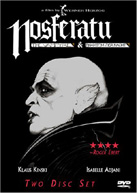Nosferatu: Phantom Der Nacht
| Dreadful is one of those words in the English language that has virtually lost its original meaning. Now used commonly to describe something that is "terrible" or "bad" ("That was a dreadful book, don't read it"), its primary meaning is "causing or inspiring fear or dread," and it is in this sense that I describe Werner Herzog's Nosferatu: Phantom Der Nacht as a thoroughly dreadful film. Slow, contemplative, and strikingly evocative, Nosferatu is no sense "scary" or "frightening." There are no "boo" moments, and it won't ever make you jump out of your seat. Instead, it casts a spell over you, drawing you into its dark, melancholy realm in which vampirism is viewed as a sad curse and the sacrifice of innocence is not enough to ward off the encroaching darkness. Not surprisingly, Nosferatu is a very European horror film, one that draws its sense of dread from the fear of the ancient--a barely repressed world of curses, ghosts, and the undead. Set at the turn of the century (the same timeframe as Bram Stoker's source novel, Dracula), Nosferatu can be clearly read as an exploration of old-world horror bleeding into the rapidly progressive world of modernity. Count Dracula comes to stand for all that is horrific about ancient superstition, particularly in how misplaced he seems once he leaves his crumbling castle. A remake of one of the great German silent classics, F.W. Murnau's Nosferatu (1922), which was an unauthorized adaptation of Dracula, Herzog's film plays by the rules of the vampire subgenre but forges a path all of its own, foregoing easy frights and graphic gore for an almost spiritual approach. Herzog works marvels with long takes, handheld tracking shots, and odd angles, at many moments appropriating the aura of a Romantic painting. He and cinematographer Jörg Schmidt-Reitwein (in their fourth of seven collaborations) paint the film out of natural light in all its various incarnations, from the blazing sun of midday, to the evaporating gray of dusk, to the pitch black of night. One of the most heralded shots in the film is a long take of a gathering storm that moves slowly over a mountain peak, blocking out the last rays of sun, an apt visual metaphor for the film's slow, but steady journey into darkness. Those familiar with Bram Stoker's story will immediately recognize the bare outline of the narrative. Jonathan Harker (Bruno Ganz), a diligent young real-estate agent, is send to the mysterious country of Transylvania to close a deal on a new house with an eccentric count named Dracula (Klaus Kinski). Harker makes the multi-week journey, encountering gypsies along the way who warn of the death and decay that surround the count's castle. At times they suggest that castle might not really exists, which plays well with the way in which vampires, by their very nature, transgress the divide between the living and the dead. Klaus Kinski, who starred in a number of Herzog's most celebrated films (including the lead in his extraordinary 1972 film Aguirre, the Wrath of God), is made up to look like Max Schreck's Count Orlock from Murnau's film. That is, his head is shaved and painted white like a gleaming skull, his fingers are tipped with six-inch fingernails that give them the appearance of spidery claws, and his mouth is equipped not with the traditional canine vampire teeth, but rather rodent-like fangs in the front. However, Kinski's performance could not be any different front Shreck's. While Shreck played the vampire as an insect-like creature of no soul, Kinski's is the tortured embodiment of life eternal, trapped in an endless cycle of life through destruction and hating every minute of it. Kinski's performance seems subdued (especially considering the physical and emotional vigor of his other roles), but his eyes constantly betray Dracula's deep sorrow for his place in life. As in Stoker's story, Dracula eventually leaves Transylvania and heads west to find Harker's thin, porcelain-skinned wife, Lucy (Isabelle Adjani), with Harker trailing just behind. It is the incursion of the ancient into the modern that drives much of the dread of Dracula's presence, which Herzog underscores visually by giving us long shots of the city and then allowing Dracula to emerge suddenly in the foreground unannounced. Continuing the European horror tradition, Dracula brings with him a plague that quickly reduces the Harkers' peaceful city into anarchy and desolation, the streets teeming with thousands of rats and funeral processions that have coffins numbering in the dozens. Throughout the film, Herzog maintains a slow, somber pace, which evokes an eerie, dreamlike aura. The dialogue is sparse and plain, and when characters do draw too much attention to themselves (for example, Roland Topor's giddy, cackling Renfield), it is a distraction. Yet, such moments are few and far between, and the majority of Nosferatu draws you in with painterly imagery and a constant, foreboding sense of barely discernable fear, the kind that lies low in your gut. In other words, it is absolutely dreadful.
Copyright © 2002 James Kendrick | |||||||||||||||||||||||||||||||||||||||||
Overall Rating: 


 (3.5)
(3.5)


